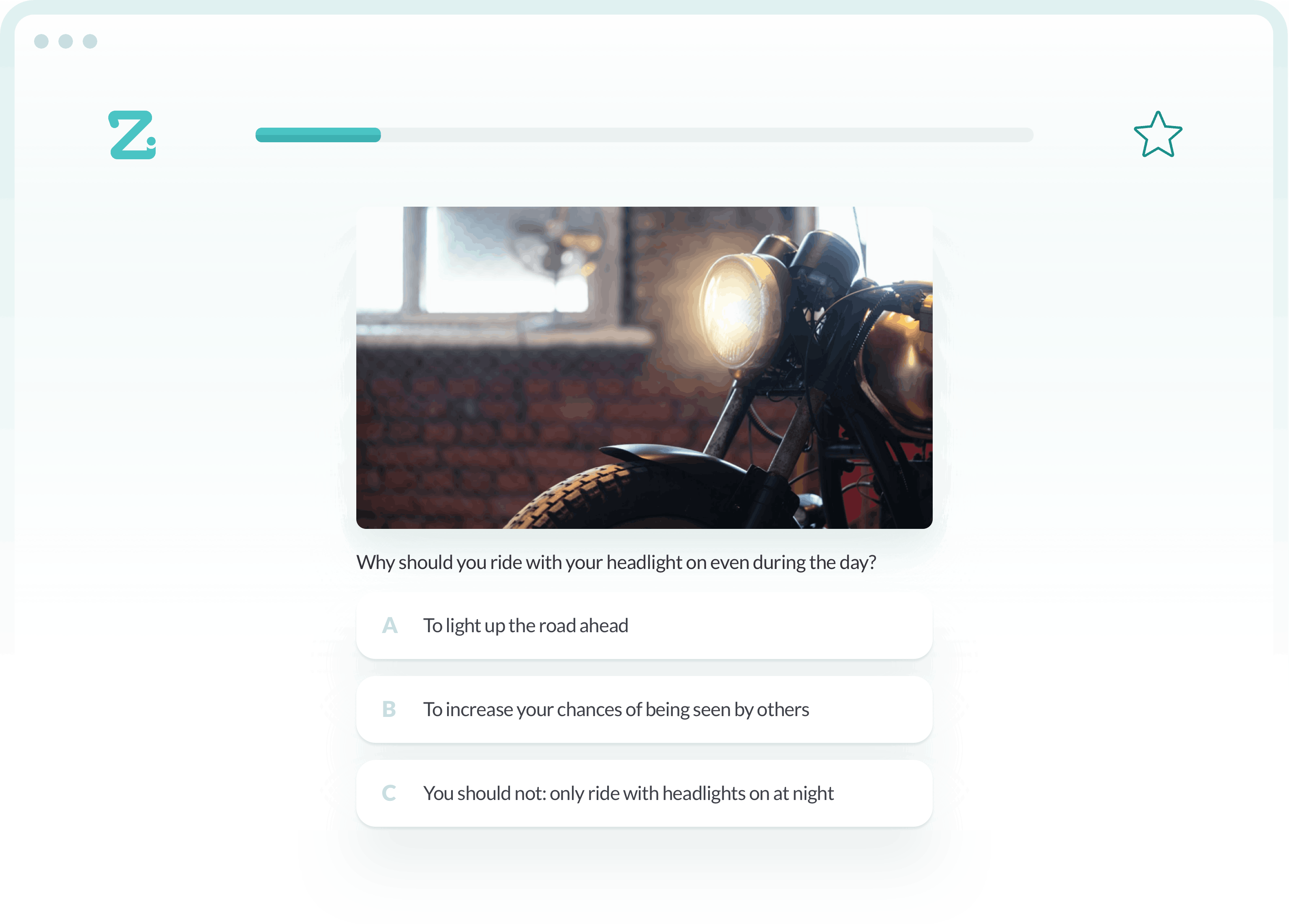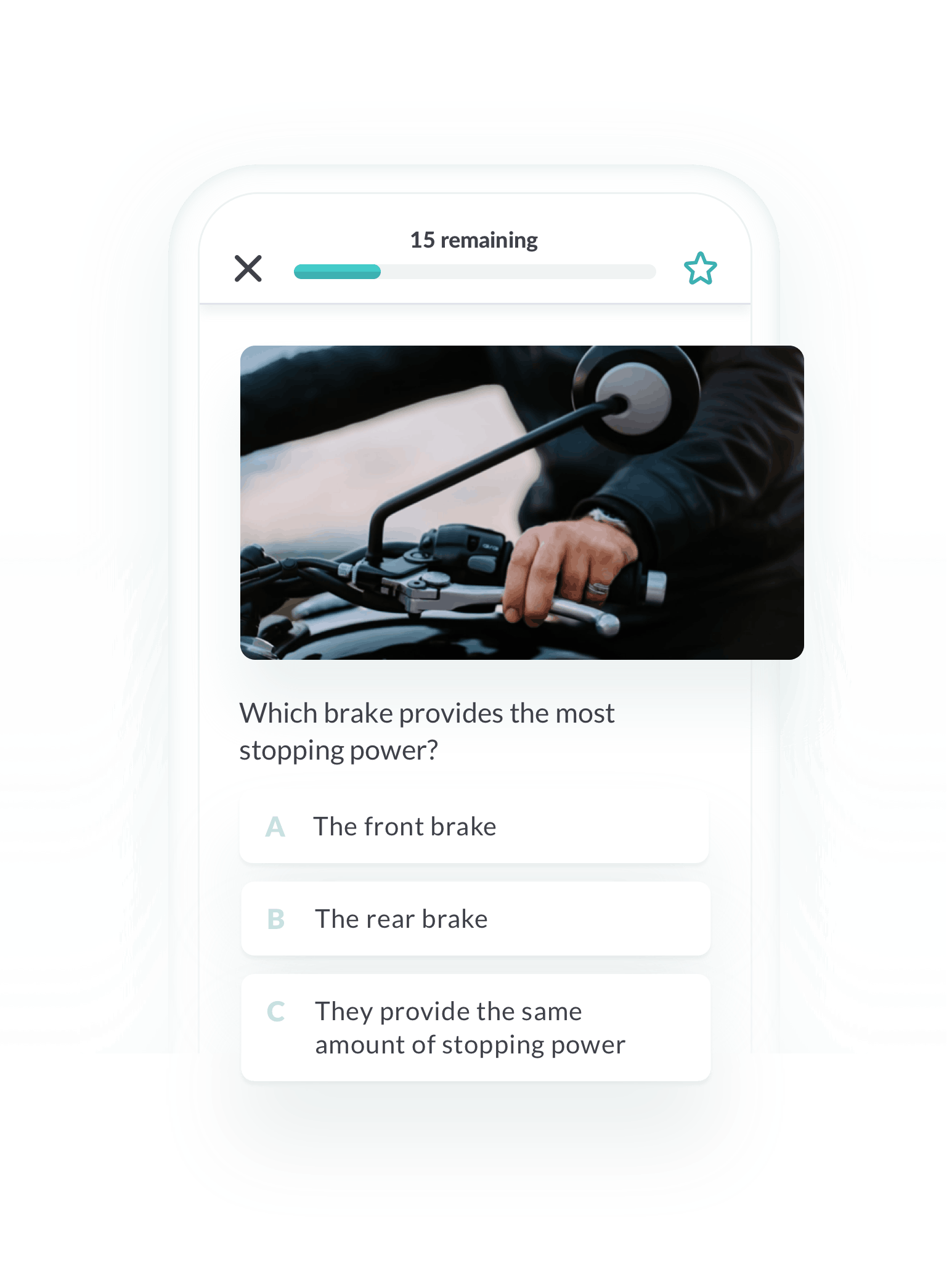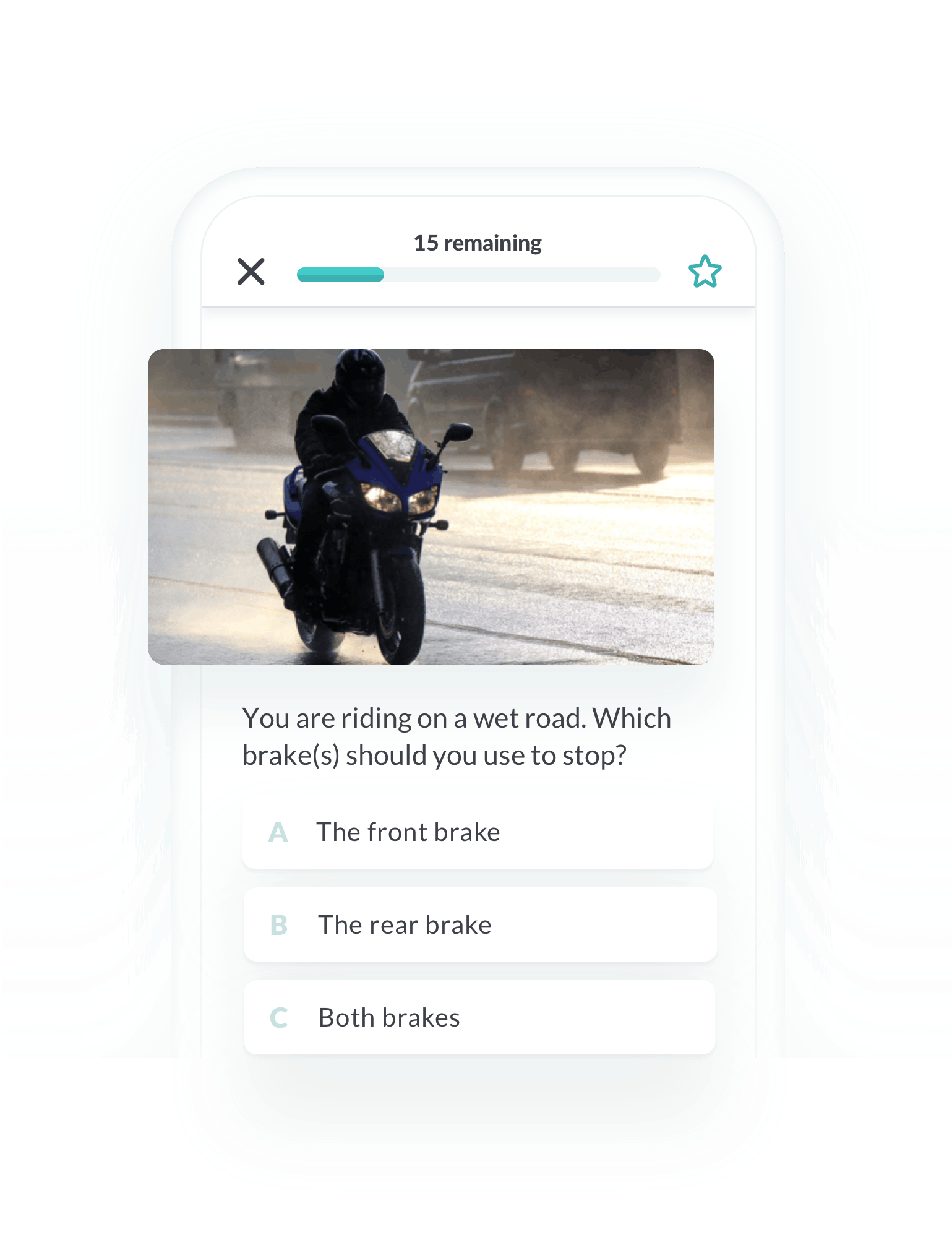You’ll take the motorcycle permit test at your local DMV or driver licensing office. Some states may have a third-party option as well. Check your state’s licensing website to find a convenient location, and be sure to schedule an appointment if necessary.
FREE 2026 Motorcycle Permit Practice Test
Select Your State

If you have spent any time studying your state’s motorcycle operator’s manual in order to pass your motorcycle permit test, then you know it’s not the most productive study tool. To prevent failing the test, you need to study using a method that works.
Zutobi is the online learning platform that specializes in helping drivers of all types prepare for and pass their permit tests. We have gamified the process of learning the rules of the road and can help you learn all of the information you need to know in a fun, engaging way.
,Pass Your 2026 State DMV Motorcycle Test with Zutobi
Zutobi offers several unique features to help you pass your motorcycle permit test on your first try. These features include:
- State-specific motorcycle permit practice tests that simulate the real written exam to help you feel prepared and comfortable on test day.
- Fun, interactive learning levels that help you stay motivated as you earn points and achievements.
- Answers and explanations to all of our practice test questions give you instant feedback so you can learn the correct answers and the reasoning behind them.
- Test-relevant, important information that you need to know in order to pass your motorcycle permit exam. Learn everything from road signs to traffic laws and regulations for motorcyclists.
- Our practice test questions and answers are near-identical to the actual state permit tests, so they make the perfect study guide for your motorcycle test.
Can I Get My Motorcycle Permit Online?
Most states require riders to take and pass an in-person written exam and vision test in order to earn their motorcycle permit. You cannot get your permit online in most states.

How Hard Is the Test?
The motorcycle test is a multiple-choice test, normally 25-30 questions long. Around 80% is usually considered a passing grade in most states. On the test, you’ll have to select the correct reaction of a motorcyclist in various traffic situations. You may also be tested on various hand signals, highest-risk situations, and motorcycle safety precautions.

Where Can You Take the Motorcycle Test?
How Many Questions Are on the Motorcycle Permit Test?
The Number of questions you’ll have to answer on the motorcycle test varies state by state, but there are generally 25-30 questions. To pass the test, you’ll have to get a passing grade, which also varies. 80% is a common minimum passing grade in many states.
Are There Any Requirements to Take the Test?
First, you will need to make sure that you are old enough to take the DMV motorcycle test. Required age varies between states – 14-16 years is common. If you have reached the required age, have obtained parental permission if necessary, and hold a valid driver’s license, you can schedule your test at a nearby licensing office.
How Can You Prepare to Make Sure You Pass the DMV Motorcycle Test?
If you want to pass your test, you’ll have to put some effort into it. It’s a good idea to read through the motorcycle operator’s manual for your state, which will contain all the information you need to know. You’ll also want to do some motorcycle practice tests before taking the real thing. Start practicing well in advance so you have the time to properly learn all you need to know.
Do You Need to Schedule Your Test?
You may or may not have to schedule an appointment to take your motorcycle permit test. Check your state’s licensing website to find out if walk-ins are allowed. If you do need to schedule your test, you can usually make the appointment online or by phone.
How Many Times Can You Take the Motorcycle Permit Test?
This varies between states. Many states have you wait a set amount of time, such as one business day between attempts. If you fail the test a certain number of times, you may have to wait longer. However, even if you fail multiple times, you’ll continue to be allowed to reattempt as long as you’re willing to wait between attempts.
What Do You Need to Bring to the Motorcycle Test?
You’ll need various identification documents, such as a social security card, driver’s license, and/or birth certificate. Applicants under 18 may need a parent to accompany them and provide identification. Proof of residency and legal presence may also be needed. Remember to bring the required fees as well.
You have recently changed your motorcycle battery. How should you get rid of the battery?
You have recently changed your motorcycle battery. How should you get rid of the battery?
Batteries must be disposed of safely as they contain acid that can be harmful to the environment. Take your used battery to an appropriate disposal site.
How many seconds up your intended path of travel should you look?
How many seconds up your intended path of travel should you look?
Scan your path of travel to identify potentially hazardous situations. Look about 10 to 15 seconds ahead.
Any time you approach an intersection:
Any time you approach an intersection:
To reduce your reaction time, you can cover the clutch and both brake levers in high-risk areas where you may have to act quickly. These areas include schools, construction zones, parking lots, and intersections. Increasing the following distance and slowing down is also a good idea, but they will only give you more time to react, not reduce your reaction time.
You can reduce your speed as you approach an intersection as well, but nothing says it has to be 20 mph. However, do not slow down a lot or change position when you are within the intersection as other drivers may think you are preparing to turn.
Will you use the road most efficiently when you pair up (ride alongside another) rider?
Will you use the road most efficiently when you pair up (ride alongside another) rider?
When group riding, you should never ride directly alongside another rider as there will be no place to go if you spot a hazard on the road. You can either ride in a staggered formation (like a zig-zag line) or a single-file formation. These formations are good for different things, so you may have to shift formation frequently.
Should you always check your blind spot and mirrors before changing lanes?
Should you always check your blind spot and mirrors before changing lanes?
Changing lanes without checking the blind spot is a common cause of side-swipe accidents. To avoid an accident, always signal and then check your mirrors and the blind spot before changing lanes.
A motorcycle's horn is _____.
A motorcycle's horn is _____.
A motorcycle's horn won't be as loud as other vehicles', but this also means you can use it more freely. Use it whenever you need to get someone's attention quickly.
Motorcycle riders should:
Motorcycle riders should:
You cannot be certain that others will see you or yield the right-of-way. Adapt your riding so you won't crash as a result of someone else's negligence.
You’ve just taken some cough medicine. What should you do before riding?
You’ve just taken some cough medicine. What should you do before riding?
Never drive without first checking the side effects of your medicine. Even cough medicine can affect your safe riding or driving ability.
What should motorcycle passengers do?
What should motorcycle passengers do?
Passengers must hold on at all times, not just when asked to by the rider, and should keep their feet firmly placed on the foot rests even when stopped. They should be positioned as far forward as possible without crowding the rider.
When approaching a railroad crossing, you should always:
When approaching a railroad crossing, you should always:
Railroad crossings are dangerous, which means you need to be careful om approach. Slow down on approach and be prepared to stop - look in both directions for approaching trains even if the lights are not flashing. Remember that lights/signals can and do malfunction.
When tailgating another vehicle you:
When tailgating another vehicle you:
You should never tailgate another road user! Tailgating leads to a limited view of the road ahead, and you will have less time to react in case the driver in front brakes. For these reasons, tailgating is a common cause of rear-end collisions.
How can you calculate the following distance?
How can you calculate the following distance?
Increase the following distance if too close. Maintaining a sufficient following distance is vital to prevent unnecessary accidents as it’ll give you more time to stop if you have to.
Your vehicle will use more fuel when:
Your vehicle will use more fuel when:
Check your tire pressure frequently. Low tire pressure will increase the rolling resistance and therefore your vehicle will need to work harder to compensate.
A motorbike will be easier to manuever when the weight is kept:
A motorbike will be easier to manuever when the weight is kept:
If you centralize the weight, it will be easier to control the motorcycle.
What does the "Evaluate" in Search, Evaluate, Execute (SEE) mean?
What does the "Evaluate" in Search, Evaluate, Execute (SEE) mean?
SEE is a three-step process that motorcycle riders can use to make appropriate judgments and apply them correcly. It stands for Search, Evaluate, Execute. "Evaluate" is focused on evaluating how a hazard can affect you and have a plan in place to reduce risks. For example; evaluate how traffic traffic control devices will affect traffic up ahead, how you should avoid potholes etc., when other vehicles may move in front of you (near a highway exit, for example).
Which brake(s) should you use when riding on slippery surfaces?
Which brake(s) should you use when riding on slippery surfaces?
In slippery conditions, always use both brakes. While neither brake will be as effective, you can use both brakes for maximum braking pressure. The front brake is still more effective than the rear brake, even on slippery surfaces.
Which of the following road environments offer the greatest chance of an accident?
Which of the following road environments offer the greatest chance of an accident?
Intersections are any place traffic may cross your path. For motorycle riders, intersections are especially dangerous as riders are not as easily spotted as others. Over half of all motorcycle/car accidents are caused by drivers that enter the rider's right-of-way - and it's often because they simply did not see the rider.
Diamond markings indicate:
Diamond markings indicate:
Diamonds painted in a lane indicate a ‘High Occupancy Vehicle’ (HOV) lane.
What does lane splitting mean?
What does lane splitting mean?
Lane splitting is also known as lane filtering. It refers to when motorcyclists ride between stopped or slower-moving traffic, or to the front of traffic stopped at a traffic light. Lane filtering can be dangerous as drivers won't expect a motorcyclist there and may change lanes suddenly, open a door, or something similar.
Upon looking in your rear-view mirror, you notice that another driver is tailgating you. Which statement is true?
Upon looking in your rear-view mirror, you notice that another driver is tailgating you. Which statement is true?
If you are being tailgated, you should allow for the tailgater to pass by slowing down and/or changing lanes. Lightly tap your brakes a couple of times to warn the tailgater that you are about to slow down.
Consider pulling over to let the tailgater pass if you’re riding on a two-lane road where passing is prohibited.
Try Our FREE State Motorcycle Permit Tests
You can check out your state page below to find a free DMV motorcycle practice test. Test what you think you already know, then sign up to our popular course if you want to pass your actual test with certainty.
- Driver’s License Renewal
- How to Get Your US Driver’s License
- How to Prepare for Your Road Test
- How to Get a Driver’s Permit
- Behind-The-Wheel training
- Courses
- Blog
- FAQ
Show More